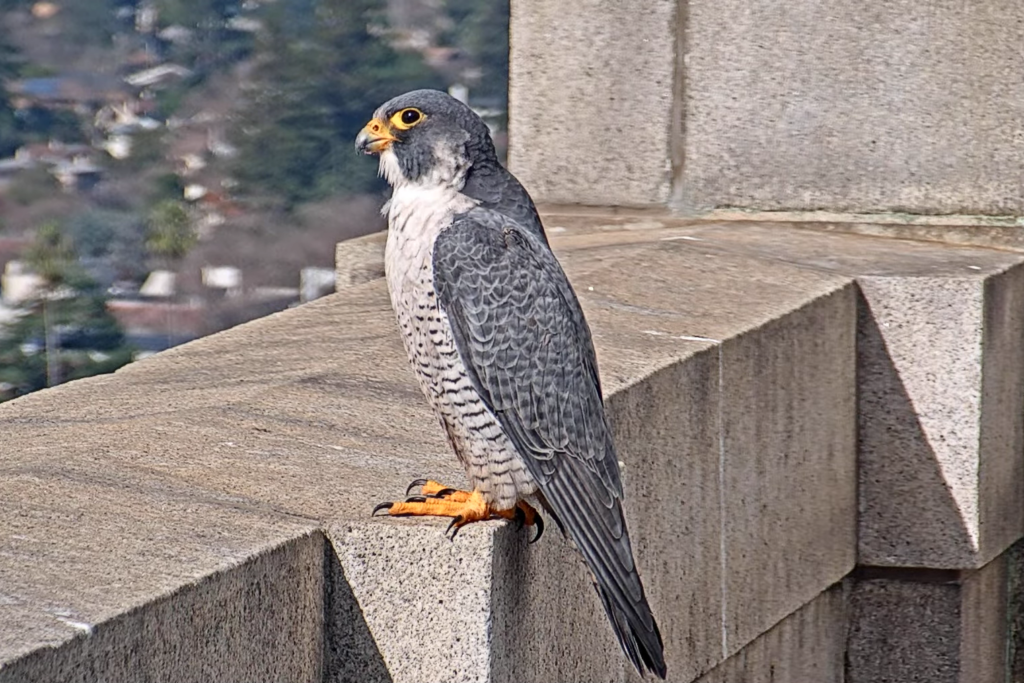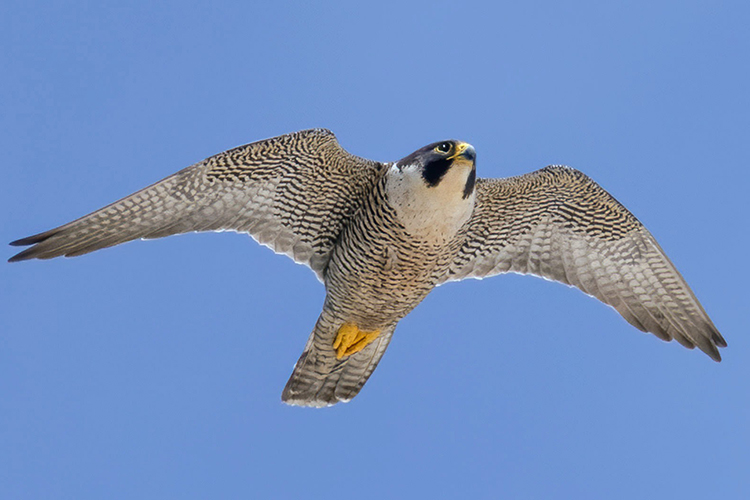Nesting season is here, with a new mate for Annie, UC Berkeley’s longtime peregrine falcon
Lou, Annie's partner after losing both Grinnell and Alden in 2022, disappeared in early January.

Cal Falcons for UC Berkeley
January 30, 2024
Atop UC Berkeley’s Campanile, it’s nesting season again for Annie, the campus’s longtime female peregrine falcon. But her mate, Lou, is missing. The two had been a pair for about a year and last spring produced and raised chicks Zephyr, Luna and Rosa.
“Unless he shows up at the tower again, I doubt we’ll ever know what happened to Lou,” said Sean Peterson, an ecologist with Cal Falcons, adding that Lou had no identification bands and that avian flu could be the culprit. “The current strain, HPAI, hits waterbirds and raptors particularly hard.”
Still, nothing is stopping Annie, who is now about 10 years old, from entering what will be her eighth breeding season at Berkeley: She’s already mating with a new falcon that showed up yesterday, and she’s welcomed him into the nest.
“She was definitely soliciting him very aggressively, so she wants him around,” said Mary Malec, a member of Cal Falcons who monitors raptor nests for the East Bay Regional Park District. “Our typical egg-laying period is in mid-March, so they have plenty of time to get together and have their hormones sync up. It’s very encouraging.”

Bridget Ahern for UC Berkeley
This news adds to the campus’s falcon drama, which over the past few years has included the death in March 2022 of Annie’s longtime mate, Grinnell; the disappearance later that year of her next partner, Alden; falcons trying to wrest away Annie’s territory; and drones flying dangerously close to the tower.
Annie has raised 18 chicks at Berkeley; the eggs hatch in April. Two of her offspring, Lux and Lindsay, died as youngsters on campus. A third chick, Sequoia, was last seen in San Jose and disappeared in 2023 shortly after his mate, Shasta, died from avian flu.
If all goes well with the new male at Berkeley, Cal Falcons soon will launch a public contest to name him, likely announcing the winning name on Valentine’s Day. Lou was named last year following a contest that began Feb. 14.
Malec said she’d become concerned when Annie was alone this month for about three weeks, after Lou dropped out of sight.
“Alden showed up within seven hours of Grinnell’s death, and Lou arrived within days of Alden’s disappearance,” she said. “This took a little longer. But Annie was talking, or chupping, with someone on the periphery for a while, either this guy or a whole series of guys who may not have come in.”

Cal Falcons for UC Berkeley
Peterson described the new male as “very svelte. He’s got a pretty sleek outline. In contrast with some of Annie’s other mates, he’s got a much lighter gray color on his head and a little bit of light gray/white just above his beak.”
He also seems “relatively relaxed about his new mate,” Peterson added.
Malec said the new male is younger than Annie and “a little bigger than Lou, and looks longer and leaner.” He hasn’t yet been seen hunting for Annie, but she said he could be providing her with meals off camera. There are three webcams on the Campanile, offering a 24/7 glimpse into the campus falcons’ lives.
Life for Lou and Annie appeared “very chill” last fall, said Peterson. “There was an occasional interloper,” he explained, “but nothing abnormal. There were always a lot of unknown birds moving around during fall migration and winter. Annie and Lou were seen pretty regularly, and nothing seemed out of the ordinary.”
Lou had even begun a new mating season with Annie recently by bringing her several meals, and the two had been engaging in courtship displays. “It seemed everything was on track,” said Peterson.
On average, falcons are in their territories for about four to five years. But at Berkeley, with the exception of Annie, who arrived on campus in 2016, there has been more turnover than expected, “although it certainly could just be bad luck,” said Peterson.

Bridget Ahern for UC Berkeley
Avian flu, which is ravaging domestic and wild birds worldwide, can’t be overlooked, especially this new strain, he added. “Some research out of the Netherlands estimated that they had a 50% mortality rate in their population of peregrine falcons,” Peterson said.
Both Sequoia and Shasta are believed to have died of avian flu last year after setting up territory on San Jose City Hall.
Fortunately, there’s also good news. In addition to the arrival of a new mate for Annie, two of her offspring — all her chicks receive ID bands — appear to be thriving.
Zephyr was spotted by a photographer near Vallejo last fall in the San Pablo National Wildlife Refuge. And Lawrencium, “Larry,” from Annie and Grinnell’s 2018 brood, continues to live on Alcatraz Island and produced four chicks that fledged in 2023.
“We’re lucky to have a few things working in our favor (with falcon sightings),” said Peterson, adding that the Bay Area has a “band report rate” of about 18%, compared with other areas that have a rate below 1%.
“The Bay Area has exceptionally good peregrine habitats, so dispersing juveniles do not need to go far to find a spot,” he said. “And there are a lot of eyes looking for birds, a lot of bird watchers in the Bay Area, compared with many other urban settings.”
Despite the loss of several mates in the last few years, the peregrine falcon population in the Bay Area is doing well, Peterson said.
“That we have a new mate showing up on Annie’s doorstep relatively quickly suggests that the population of peregrines in the Bay Area counties continues to be healthy,” he said. “Hopefully, the last couple of years were just bad luck and Annie and her new mate will have an extended time together.”